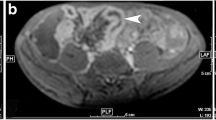Abstract.
Driven by the improvements in gradient technology, breathhold T1- and T2-weighted imaging of the abdominal structures has become possible. These techniques allow exploitation of the advantages inherent to the MR imaging experiment: unsurpassed soft tissue contrast and multiplanar imaging capabilities. Magnetic resonance imaging of the small and large bowel has thus moved from a hypothetical possibility to a practical reality. This manuscript describes some of the underlying fast imaging techniques for display of the small and large bowel. Furthermore, it discusses the plethora of available oral and rectal contrast agents. Finally, clinical indications for MR of the small and large bowel as well as the rectum are decribed in light of the available literature. Advantages and disadvantages relative to computed tomography and othe imaging techniques are discussed.
Similar content being viewed by others
Author information
Authors and Affiliations
Rights and permissions
About this article
Cite this article
Debatin, J., Patak, M. MRI of the small and large bowel. Eur Radiol 9, 1523–1534 (1999). https://doi.org/10.1007/s003300050878
Issue Date:
DOI: https://doi.org/10.1007/s003300050878




